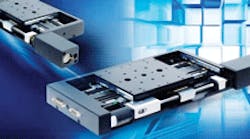Edited by Robert Repas Resources: Feinmess Dresden GmbH, www.feinmess.de MicroMo Electronics Inc., www.micromo.com PiezoMotor AB, www.piezomotor.se |
Whether in electronics, mechanical engineering, or biology, miniaturization brings demands for dimensional accuracy. Simply adopting a downsized standard method from the big world won’t work.
The conventional way of getting accurate micromeasurements is to move the object being measured past a measuring probe using piezo actuators. The probe operates in a manner similar to a coordinate-measuring machine, returning a signal when contact is made. The position of the measured object is then read from the piezo drive. Several readings taken at different points determine the object size.
In this regard, piezo drives are known for their capacity to deliver ultrafine stepwidths for accurate positioning and thus create accurate measurements. But because they only move in small increments, the payload moves slowly from position to position. While perfectly fine for taking measurements, it may take several minutes to move the payload into proper measuring position, with a corresponding loss in production. On the other hand, dc servomotors can move things quickly into measuring position. However, they have limited slow-speed precision without the use of gear reductions that cap their maximum speed. All in all, the use of brush or piezo actuators alone can be suboptimum for moving objects into measuring position.
One technique used to speed things up combines a fast dc drive with a high-precision piezo rotary drive mounted on a common spindle. The dc drive provides rapid delivery to the measurement point, while the piezo drive resolves the actual measurement.
Precision movement specialist Feinmess Dresden GmbH, Germany, developed a fast, nonprecision transport using a geared dc motor with the fine adjustment handled by a high-precision piezomotor. The Faulhaber Group, Germany, supplied both motors for the design and worked with Feinmess Dresden to optimize the drive controller so both motors perform their specific tasks in harmony.
Ultrasmall-scale motion involves different principles than those on which normal positioners operate. Because of the short distances covered, the key factor weighing on positioning time is not the maximum speed of the drive. The critical factors are the acceleration time, deceleration time, and the total distance covered during the initial setup to the measured points.
Precision measurement specialists at Feinmess Dresden split the tasks into individual drives for each type of movement. A backlash-free ball screw lets a motor sit at each end of the screw. This also lets the positioning equipment employ extra components that make the system more efficient in many applications. Another advantage is that, theoretically, there is no limit to the feed length. The ball screw can be the length needed to fit the application without any special adaptations.
Such a configuration lets the system rapidly take multiple measurements on large objects during a single clamping operation. In contrast, conventional or stacked piezo drives restrict measurement length to just a few millimeters.
A conventional brush motor with rotary encoder connects to the shaft via a bellows coupling to position the object quickly for measurement. The motor generates negligible heat because it runs for a relatively short time, so any error caused by thermal expansion is minimal. Practical speed ranges from 0.5 to 100 mm/sec depending on the spindle pitch used. This corresponds to the rough positioning value in many standard designs.
Conventional precision motors with graphite commutation can handle the dc-drive chores. Faulhaber adapted standard motors to the application, using different models depending on the torque needed. For example, in one case the 23-mm-diameter motors can reach approximately 7,000 rpm with up to 16-mNm torque.
As the linear stage approaches the desired position, the dc drive powers down and the system switches to high-precision mode using the rotary piezomotor. For this application, the Faulhaber Group company PiezoMotor AB, Sweden, supplied the piezomotors. Linked to the shaft using a permanentmagnet coupling, the piezomotor takes over when the linear speed of the stage drops below 0.5 mm/sec
The dc drive, of course, generates no heat when it is shut down. The piezomotor also generates little heat. All in all, there’s no need for heat compensation during the measurement. At rest, the piezo drive acts as a passive spindle brake, damping oscillations and preventing unwanted motion in the positioner system.
A high-resolution linear-measuring system continuously records stage movement and transmits position information to the motor controller. In this way, the piezo drive moves the linear positioner in high-precision mode at speeds from 0.02 to 150 m/sec. How constant the velocity remains at the bottom end of the range depends only on the resolution of the linear scale. Repetition accuracy typically produces errors less than 100 nm. By splitting the positioning task between the dc and piezo drives, the ratio of the fastest to slowest speed in a given range can reach over a million to one.
